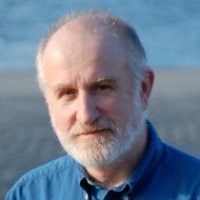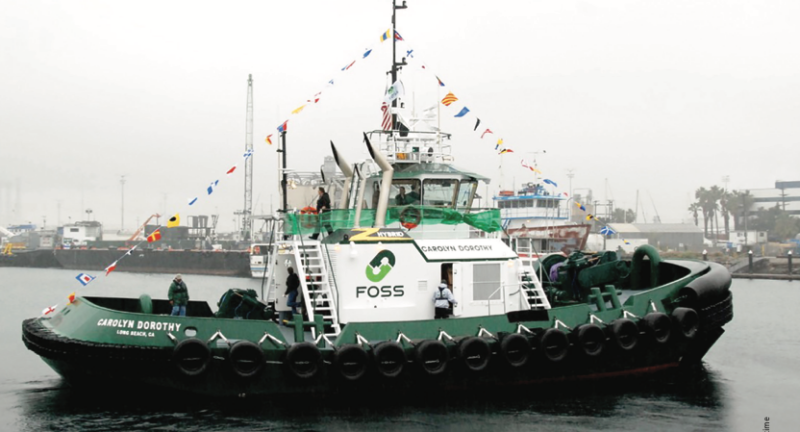Anytime there’s a legit, suitably notable “first-in-the- world” introduction, it’s usually a big deal. Such it was on a rainy day in 2009 when Foss Maritime unveiled the world’s first hybrid tug, the Carolyn Dorothy. Maybe 300 guests heard speakers from Foss and the ports of Los Angeles and Long Beach tout the new environmental credibility of the tug, which was the point of the ports’ $1.3 million grant money that helped build it.
The tug’s hybrid concept was developed after Foss analyzed its harbor tugs’ duty cycles in LA/LB and realized that maximum power was only needed a small part of the time, but the 78'×34' tug would still need to have about 60 tons of bollard pull. Foss and its partners, which include Cummins Northwest, Seattle; Robert Allan Ltd., Vancouver, B.C., the vessel designer; and Aspin Kemp & Associates (AKA), a Canadian electrical-engineering company, came up with a plan to tailor the tug’s power generation to fit the need at any given moment. This new hybrid idea combined conventional mechanical drives with electric drives. With motor-generators installed in-line behind the main engines and in front of the Z-drives, power from both batteries and diesel generators could all throw horsepower into the drive shaft. And conversely, the motor-generators could generate juice when spun by the main engines.
For the Carolyn Dorothy, the full combination included two Cummins QSK50, 1,800-hp diesel engines, two Cummins QSM11, 300-kW gensets, two Siemens 1,200-hp/895- kW motor-generators, and 126 12-volt, lead-acid batteries. When standing by or slowly transiting, maybe only the batteries or one of the gensets would be required. Other times, maximum power meant all of the above. Operating in different modes would reduce fuel consumption and lower emissions.
GAME CHANGER
Not surprisingly, Jason Aspin, president of AKA, called it “game changing technology.”
And it worked. Testing performed by the University of California, Riverside, compared emissions from the Carolyn Dorothy to a sister Dolphin- class tug, the Alta June, with conventional propulsion. The hybrid showed a 73% reduction for particulate matter, a 51% reduction for nitrogen oxide and a 17% reduction for carbon dioxide, according to a report from the California Air Resources Board. (All diesel engines were Tier 2 at the time of testing.)
Following the construction of the Carolyn Dorothy, in 2011 Foss converted another Dolphin-class tug, the Campbell Foss, to hybrid configuration, but with lithium-polymer batteries as well as motor-generators and a computerized energy management system. However, in 2012, part of the battery bank exploded and burned. As a result, Foss removed both the remaining batteries from the Campbell and all of the lead-acid batteries from the Carolyn Dorothy, which returned to service temporarily without batteries.
In 2014, Foss hired Elliott Bay Design Group, Seattle, to perform a risk-assessment study on reinstalling batteries. The team, including AKA, decided to use lithium-polymer batteries from Energy Storage Technologies on both boats and to isolate them in stern void compartments for safety. After overcoming complications of electro-magnetic interference in battery-system communications, and a fire in the Carolyn Dorothy’s engine room, both the Campbell Foss and the Carolyn Dorothy returned to service in full hybrid status in 2016, according to a report prepared by Foss’s Susan Hayman for the Maritime Administration, which supported the project with a $600,000 grant.
In the report, Hayman stated that “Foss fully believes that this technology is on the cusp of becoming widespread and is proud to have been at the tip of this revolution.”
The revolution, however, has been slow in coming. Foss itself has neither built nor converted more hybrid tugs, despite several newbuilds since 2016.
Baydelta Maritime, San Francisco, picked up on the technology in 2019 when it had Nichols Brothers Boat Builders in Washington build a hybrid tug designed by Jensen Maritime Consultants. Based on the Valor-class of boats, the 100'×40' tug was powered by two 2,675-hp Caterpillar C3516 Tier 3 main engines, three Cat C9.3 300-kW generators and one Cat C7.1 150-kW genset. Named Delta Teresa, the hybrid featured Rolls-Royce propulsion able to take power from either electric motors, diesel-mechanical, or both. There was no integrated battery bank in this hybrid system. The boat is currently operating in the Los Angeles/ Long Beach area. This is the only hybrid in Baydelta’s fleet, and the only hybrid tug built by Nichols Brothers.
COSTLY TO BUILD
A primary reason for the slow adoption of hybrid technology is the capital cost. “From a financial standpoint it didn’t make a lot of sense,” said John Walls, the sales manager at Cummins Northwest for many years. “The capital cost adds about 25 percent to the propulsion package,” he said. “So, if you look at the rates for what can be charged for ship assist, it didn’t support paying that additional one-and-a- half to two million dollars in capital costs.”
“After Carolyn Dorothy we thought there were going to be a lot more hybrids built,” said Lawren Best, the director of design development at Robert Allan. “We had a ton of questions and discussions, and it just didn’t really pick up. Now we see that pick up occurring quite heavily with more hybrid tugs and with battery-electric tugs.”
RAL recently supplied the design and engineering on the Spartan, the first of two new hybrid tugs from Master Boat Builders in Alabama for Seabulk in Florida. The boat can operate as diesel-mechanical, diesel- electric or both. There is no battery bank, although the design includes space for one.
“The electric motors are directly connected to the Z-drive,” said Best, so they’re separate from the mechanical input shaft. This arrangement is more simple and less expensive than building and installing in-line motor-generators like on the Carolyn Dorothy. “It’s a very flexible solution,” he said. “Whether that boat saves a considerable amount of fuel? Likely not. The real benefit of that propulsion configuration is that it significantly reduces running hours on equipment.”
RAL is also developing zero-emission battery-powered harbor tugs, part of the company’s ElectRA series, with three under construction in Europe to serve the LNG Canada export facility in Kitimat, B.C., Canada. They are expected to arrive in mid-2023. “The ElectRAs are designed to do the majority of work on batteries,” said Best. “They’ll have gensets on board for cases like firefighting where you need a continuous amount of power. It’s not going to be acceptable to say, oh we fought the fire for three hours but we need to go charge now.”
Crowley Maritime is also having a battery-powered tug built, also at Master Boat. The eWolf, too, will have small gensets if needed for longer transits, but the tug is expected to operate primarily on batteries only and recharge at the dock in San Diego during the night when the grid has more power available.
Crowley’s engineering team is also currently at work developing a variant of the eWolf that will be more of a true hybrid version. “It will have four generators on the main deck and azimuth drives below powered by electric motors,” said Cole Van Gundy, Crowley’s vice president of engineering and new construction. The battery bank could potentially have as much as 7.7 mWh of power, or as little as 4 mWh. The eWolf has 6.2.
The new hybrid-electric tug is being designed for an unnamed third party and is still in the concept stage. However, Van Gundy expects the project to get shipyard pricing soon followed by construction. “The numbers indicate that this is actually a more cost-competitive platform and actually generates additional revenue for the client,” he said.




